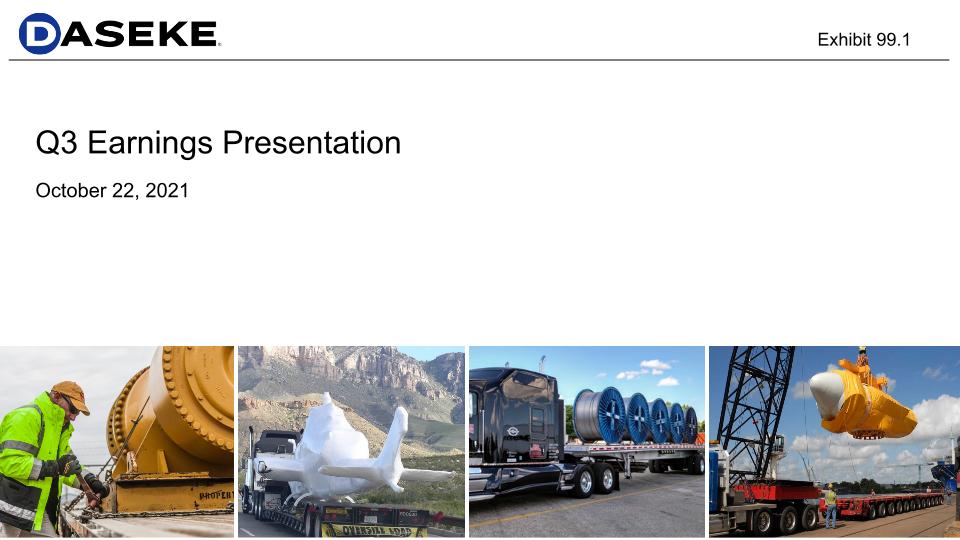
Q3 Earnings Presentation October 22, 2021 Exhibit 99.1
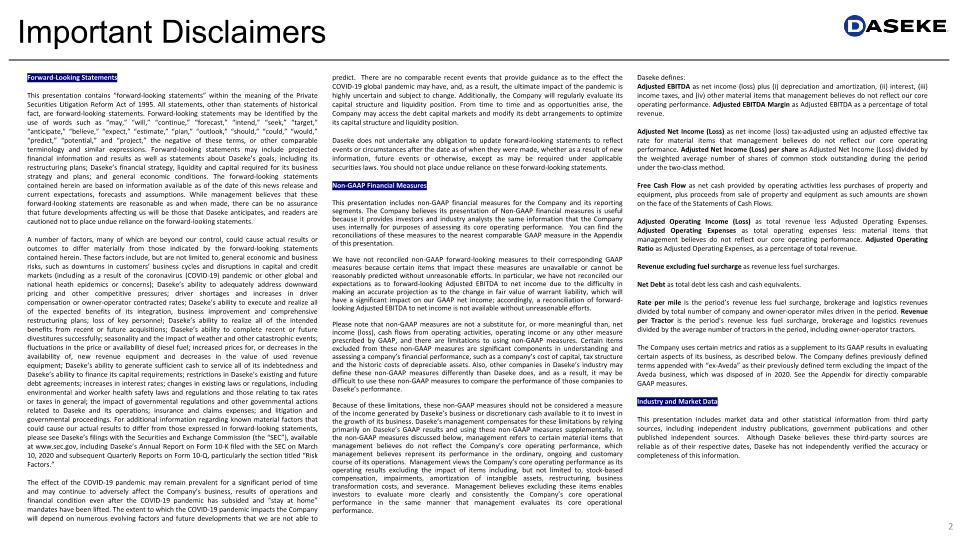
Important Disclaimers Forward-Looking Statements This presentation contains “forward-looking statements” within the meaning of the Private Securities Litigation Reform Act of 1995. All statements, other than statements of historical fact, are forward-looking statements. Forward-looking statements may be identified by the use of words such as “may,” “will,” “continue,” “forecast,” “intend,” “seek,” “target,” “anticipate,” “believe,” “expect,” “estimate,” “plan,” “outlook,” “should,” “could,” “would,” “predict,” “potential,” and “project,” the negative of these terms, or other comparable terminology and similar expressions. Forward-looking statements may include projected financial information and results as well as statements about Daseke’s goals, including its restructuring plans; Daseke’s financial strategy, liquidity and capital required for its business strategy and plans; and general economic conditions. The forward-looking statements contained herein are based on information available as of the date of this news release and current expectations, forecasts and assumptions. While management believes that these forward-looking statements are reasonable as and when made, there can be no assurance that future developments affecting us will be those that Daseke anticipates, and readers are cautioned not to place undue reliance on the forward-looking statements. A number of factors, many of which are beyond our control, could cause actual results or outcomes to differ materially from those indicated by the forward-looking statements contained herein. These factors include, but are not limited to, general economic and business risks, such as downturns in customers’ business cycles and disruptions in capital and credit markets (including as a result of the coronavirus (COVID-19) pandemic or other global and national heath epidemics or concerns); Daseke’s ability to adequately address downward pricing and other competitive pressures; driver shortages and increases in driver compensation or owner-operator contracted rates; Daseke’s ability to execute and realize all of the expected benefits of its integration, business improvement and comprehensive restructuring plans; loss of key personnel; Daseke’s ability to realize all of the intended benefits from recent or future acquisitions; Daseke’s ability to complete recent or future divestitures successfully; seasonality and the impact of weather and other catastrophic events; fluctuations in the price or availability of diesel fuel; increased prices for, or decreases in the availability of, new revenue equipment and decreases in the value of used revenue equipment; Daseke’s ability to generate sufficient cash to service all of its indebtedness and Daseke’s ability to finance its capital requirements; restrictions in Daseke’s existing and future debt agreements; increases in interest rates; changes in existing laws or regulations, including environmental and worker health safety laws and regulations and those relating to tax rates or taxes in general; the impact of governmental regulations and other governmental actions related to Daseke and its operations; insurance and claims expenses; and litigation and governmental proceedings. For additional information regarding known material factors that could cause our actual results to differ from those expressed in forward-looking statements, please see Daseke’s filings with the Securities and Exchange Commission (the “SEC”), available at www.sec.gov, including Daseke’s Annual Report on Form 10-K filed with the SEC on March 10, 2020 and subsequent Quarterly Reports on Form 10-Q, particularly the section titled “Risk Factors.” The effect of the COVID-19 pandemic may remain prevalent for a significant period of time and may continue to adversely affect the Company’s business, results of operations and financial condition even after the COVID-19 pandemic has subsided and “stay at home” mandates have been lifted. The extent to which the COVID-19 pandemic impacts the Company will depend on numerous evolving factors and future developments that we are not able to predict. There are no comparable recent events that provide guidance as to the effect the COVID-19 global pandemic may have, and, as a result, the ultimate impact of the pandemic is highly uncertain and subject to change. Additionally, the Company will regularly evaluate its capital structure and liquidity position. From time to time and as opportunities arise, the Company may access the debt capital markets and modify its debt arrangements to optimize its capital structure and liquidity position. Daseke does not undertake any obligation to update forward-looking statements to reflect events or circumstances after the date as of when they were made, whether as a result of new information, future events or otherwise, except as may be required under applicable securities laws. You should not place undue reliance on these forward-looking statements. Non-GAAP Financial Measures This presentation includes non-GAAP financial measures for the Company and its reporting segments. The Company believes its presentation of Non-GAAP financial measures is useful because it provides investors and industry analysts the same information that the Company uses internally for purposes of assessing its core operating performance. You can find the reconciliations of these measures to the nearest comparable GAAP measure in the Appendix of this presentation. We have not reconciled non‐GAAP forward-looking measures to their corresponding GAAP measures because certain items that impact these measures are unavailable or cannot be reasonably predicted without unreasonable efforts. In particular, we have not reconciled our expectations as to forward-looking Adjusted EBITDA to net income due to the difficulty in making an accurate projection as to the change in fair value of warrant liability, which will have a significant impact on our GAAP net income; accordingly, a reconciliation of forward-looking Adjusted EBITDA to net income is not available without unreasonable efforts. Please note that non-GAAP measures are not a substitute for, or more meaningful than, net income (loss), cash flows from operating activities, operating income or any other measure prescribed by GAAP, and there are limitations to using non-GAAP measures. Certain items excluded from these non-GAAP measures are significant components in understanding and assessing a company’s financial performance, such as a company’s cost of capital, tax structure and the historic costs of depreciable assets. Also, other companies in Daseke’s industry may define these non‐GAAP measures differently than Daseke does, and as a result, it may be difficult to use these non‐GAAP measures to compare the performance of those companies to Daseke’s performance. Because of these limitations, these non-GAAP measures should not be considered a measure of the income generated by Daseke’s business or discretionary cash available to it to invest in the growth of its business. Daseke’s management compensates for these limitations by relying primarily on Daseke’s GAAP results and using these non-GAAP measures supplementally. In the non-GAAP measures discussed below, management refers to certain material items that management believes do not reflect the Company’s core operating performance, which management believes represent its performance in the ordinary, ongoing and customary course of its operations. Management views the Company’s core operating performance as its operating results excluding the impact of items including, but not limited to, stock-based compensation, impairments, amortization of intangible assets, restructuring, business transformation costs, and severance. Management believes excluding these items enables investors to evaluate more clearly and consistently the Company’s core operational performance in the same manner that management evaluates its core operational performance. Daseke defines: Adjusted EBITDA as net income (loss) plus (i) depreciation and amortization, (ii) interest, (iii) income taxes, and (iv) other material items that management believes do not reflect our core operating performance. Adjusted EBITDA Margin as Adjusted EBITDA as a percentage of total revenue. Adjusted Net Income (Loss) as net income (loss) tax-adjusted using an adjusted effective tax rate for material items that management believes do not reflect our core operating performance. Adjusted Net Income (Loss) per share as Adjusted Net Income (Loss) divided by the weighted average number of shares of common stock outstanding during the period under the two-class method. Free Cash Flow as net cash provided by operating activities less purchases of property and equipment, plus proceeds from sale of property and equipment as such amounts are shown on the face of the Statements of Cash Flows. Adjusted Operating Income (Loss) as total revenue less Adjusted Operating Expenses. Adjusted Operating Expenses as total operating expenses less: material items that management believes do not reflect our core operating performance. Adjusted Operating Ratio as Adjusted Operating Expenses, as a percentage of total revenue. Revenue excluding fuel surcharge as revenue less fuel surcharges. Net Debt as total debt less cash and cash equivalents. Rate per mile is the period’s revenue less fuel surcharge, brokerage and logistics revenues divided by total number of company and owner-operator miles driven in the period. Revenue per Tractor is the period’s revenue less fuel surcharge, brokerage and logistics revenues divided by the average number of tractors in the period, including owner-operator tractors. The Company uses certain metrics and ratios as a supplement to its GAAP results in evaluating certain aspects of its business, as described below. The Company defines previously defined terms appended with “ex-Aveda” as their previously defined term excluding the impact of the Aveda business, which was disposed of in 2020. See the Appendix for directly comparable GAAP measures. Industry and Market Data This presentation includes market data and other statistical information from third party sources, including independent industry publications, government publications and other published independent sources. Although Daseke believes these third-party sources are reliable as of their respective dates, Daseke has not independently verified the accuracy or completeness of this information.
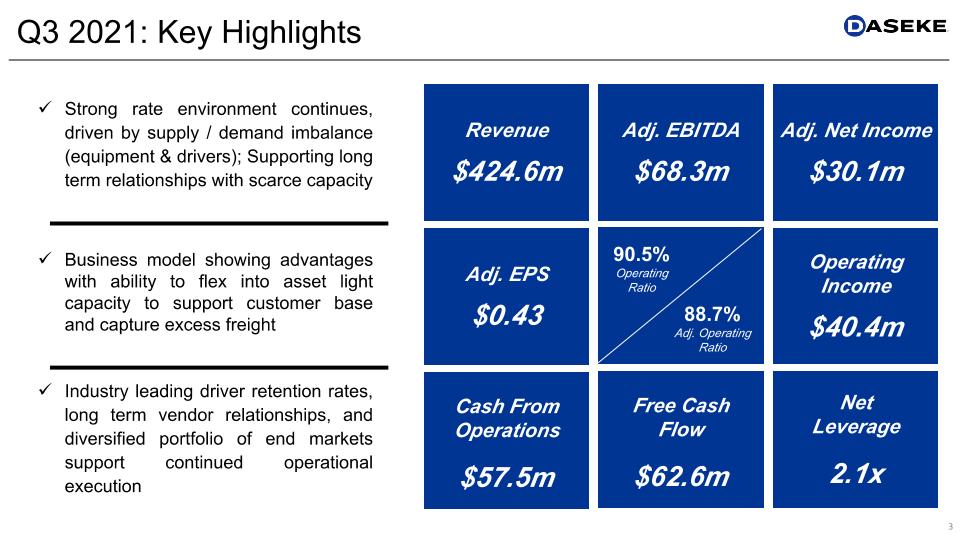
Q3 2021: Key Highlights 88.0% Adj. Operating Ratio 88.8% Operating Ratio Strong rate environment continues, driven by supply / demand imbalance (equipment & drivers); Supporting long term relationships with scarce capacity Business model showing advantages with ability to flex into asset light capacity to support customer base and capture excess freight Industry leading driver retention rates, long term vendor relationships, and diversified portfolio of end markets support continued operational execution Cash From Operations $57.5m Revenue $424.6m Adj. EBITDA $68.3m Net Leverage 2.1x Adj. Net Income $30.1m Adj. EPS $0.43 Free Cash Flow $62.6m Operating Income $40.4m 90.5% Operating Ratio 88.7% Adj. Operating Ratio 3
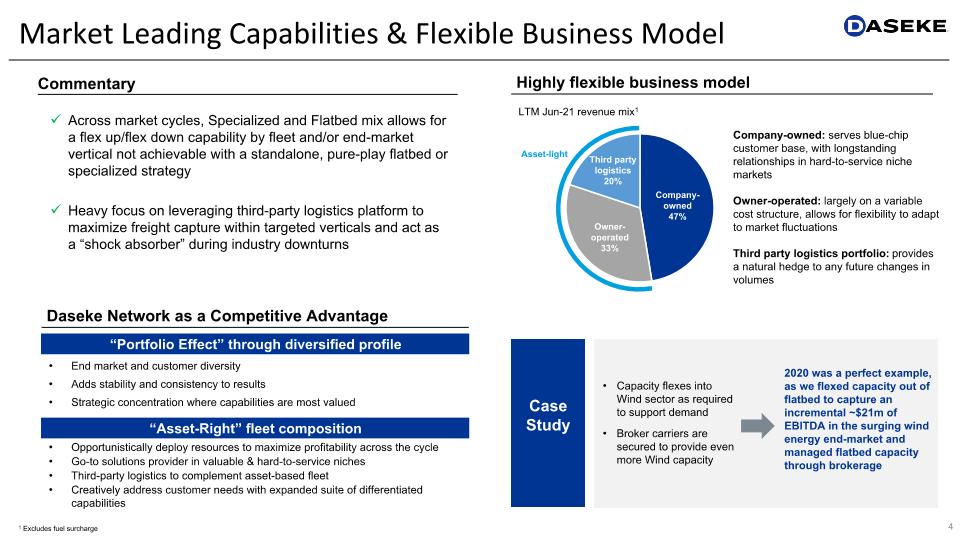
Market Leading Capabilities & Flexible Business Model Company-owned: serves blue-chip customer base, with longstanding relationships in hard-to-service niche markets Owner-operated: largely on a variable cost structure, allows for flexibility to adapt to market fluctuations Third party logistics portfolio: provides a natural hedge to any future changes in volumes LTM Jun-21 revenue mix1 Highly flexible business model Asset-light 1 Excludes fuel surcharge Commentary Across market cycles, Specialized and Flatbed mix allows for a flex up/flex down capability by fleet and/or end-market vertical not achievable with a standalone, pure-play flatbed or specialized strategy Heavy focus on leveraging third-party logistics platform to maximize freight capture within targeted verticals and act as a “shock absorber” during industry downturns Case Study Capacity flexes into Wind sector as required to support demand Broker carriers are secured to provide even more Wind capacity 2020 was a perfect example, as we flexed capacity out of flatbed to capture an incremental ~$21m of EBITDA in the surging wind energy end-market and managed flatbed capacity through brokerage Daseke Network as a Competitive Advantage End market and customer diversity Adds stability and consistency to results Strategic concentration where capabilities are most valued “Portfolio Effect” through diversified profile Opportunistically deploy resources to maximize profitability across the cycle Go-to solutions provider in valuable & hard-to-service niches Third-party logistics to complement asset-based fleet Creatively address customer needs with expanded suite of differentiated capabilities “Asset-Right” fleet composition 4
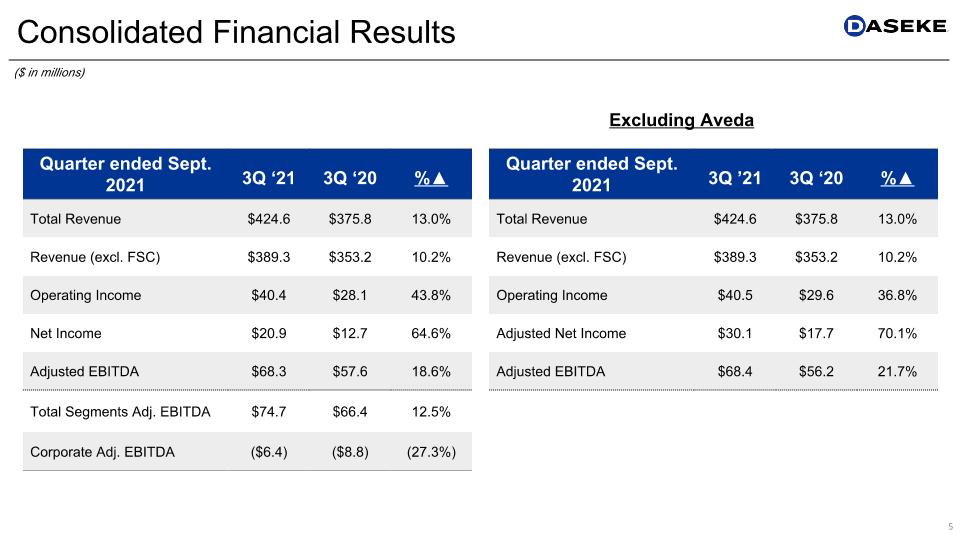
Consolidated Financial Results Quarter ended Sept. 2021 3Q ’21 3Q ‘20 %▲ Total Revenue $424.6 $375.8 13.0% Revenue (excl. FSC) $389.3 $353.2 10.2% Operating Income $40.5 $29.6 36.8% Adjusted Net Income $30.1 $17.7 70.1% Adjusted EBITDA $68.4 $56.2 21.7% Excluding Aveda ($ in millions) Quarter ended Sept. 2021 3Q ‘21 3Q ‘20 %▲ Total Revenue $424.6 $375.8 13.0% Revenue (excl. FSC) $389.3 $353.2 10.2% Operating Income $40.4 $28.1 43.8% Net Income $20.9 $12.7 64.6% Adjusted EBITDA $68.3 $57.6 18.6% Total Segments Adj. EBITDA $74.7 $66.4 12.5% Corporate Adj. EBITDA ($6.4) ($8.8) (27.3%)
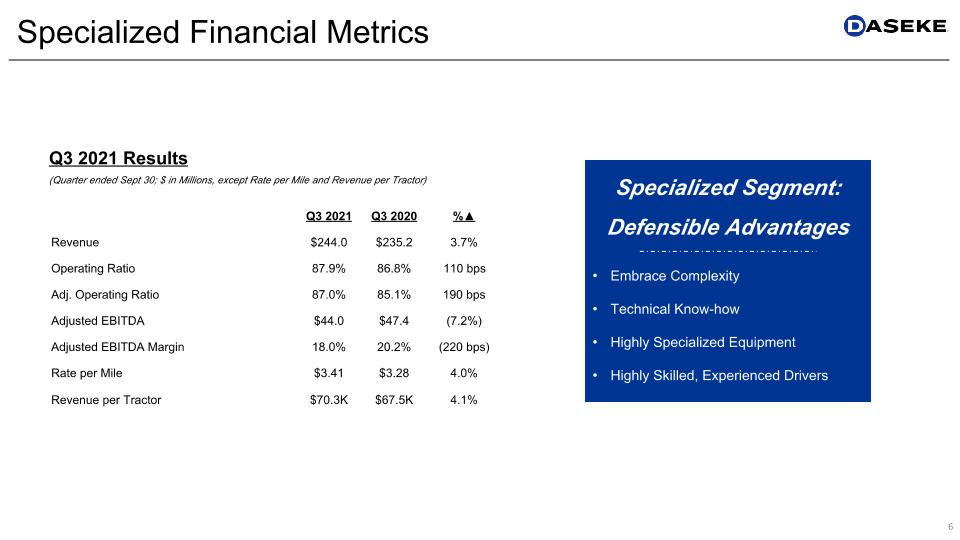
Specialized Financial Metrics Q3 2021 Q3 2020 %▲ Revenue $244.0 $235.2 3.7% Operating Ratio 87.9% 86.8% 110 bps Adj. Operating Ratio 87.0% 85.1% 190 bps Adjusted EBITDA $44.0 $47.4 (7.2%) Adjusted EBITDA Margin 18.0% 20.2% (220 bps) Rate per Mile $3.41 $3.28 4.0% Revenue per Tractor $70.3K $67.5K 4.1% (Quarter ended Sept 30; $ in Millions, except Rate per Mile and Revenue per Tractor) Q3 2021 Results Specialized Segment: Defensible Advantages Embrace Complexity Technical Know-how Highly Specialized Equipment Highly Skilled, Experienced Drivers
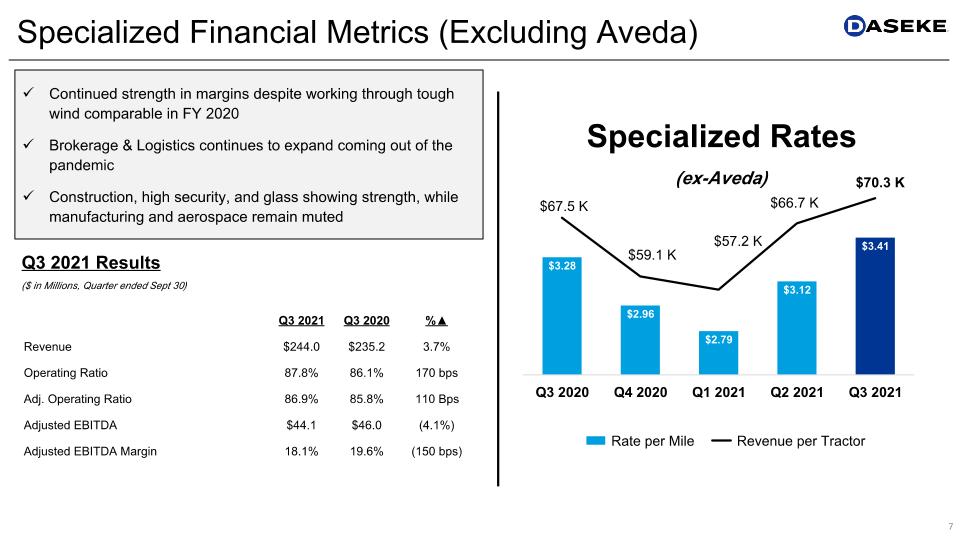
Specialized Financial Metrics (Excluding Aveda) Q3 2021 Q3 2020 %▲ Revenue $244.0 $235.2 3.7% Operating Ratio 87.8% 86.1% 170 bps Adj. Operating Ratio 86.9% 85.8% 110 Bps Adjusted EBITDA $44.1 $46.0 (4.1%) Adjusted EBITDA Margin 18.1% 19.6% (150 bps) ($ in Millions, Quarter ended Sept 30) Q3 2021 Results Continued strength in margins despite working through tough wind comparable in FY 2020 Brokerage & Logistics continues to expand coming out of the pandemic Construction, high security, and glass showing strength, while manufacturing and aerospace remain muted
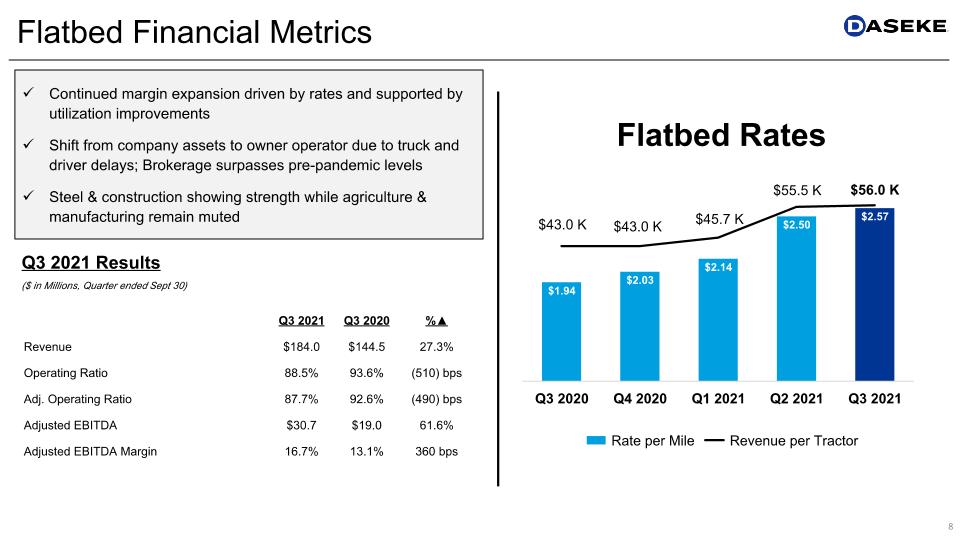
Flatbed Financial Metrics Q3 2021 Q3 2020 %▲ Revenue $184.0 $144.5 27.3% Operating Ratio 88.5% 93.6% (510) bps Adj. Operating Ratio 87.7% 92.6% (490) bps Adjusted EBITDA $30.7 $19.0 61.6% Adjusted EBITDA Margin 16.7% 13.1% 360 bps ($ in Millions, Quarter ended Sept 30) Q3 2021 Results Continued margin expansion driven by rates and supported by utilization improvements Shift from company assets to owner operator due to truck and driver delays; Brokerage surpasses pre-pandemic levels Steel & construction showing strength while agriculture & manufacturing remain muted
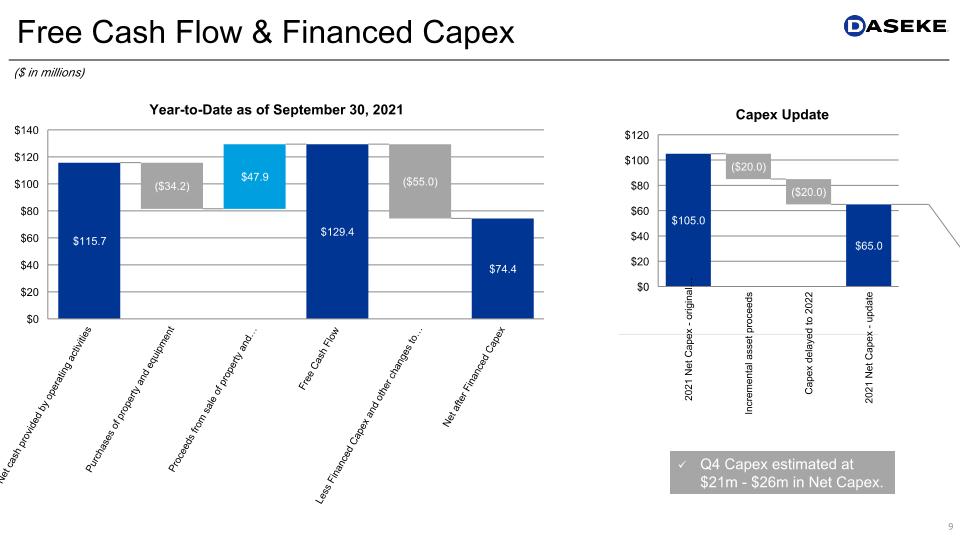
Free Cash Flow & Financed Capex Q4 Capex estimated at $21m - $26m in Net Capex. ($ in millions)
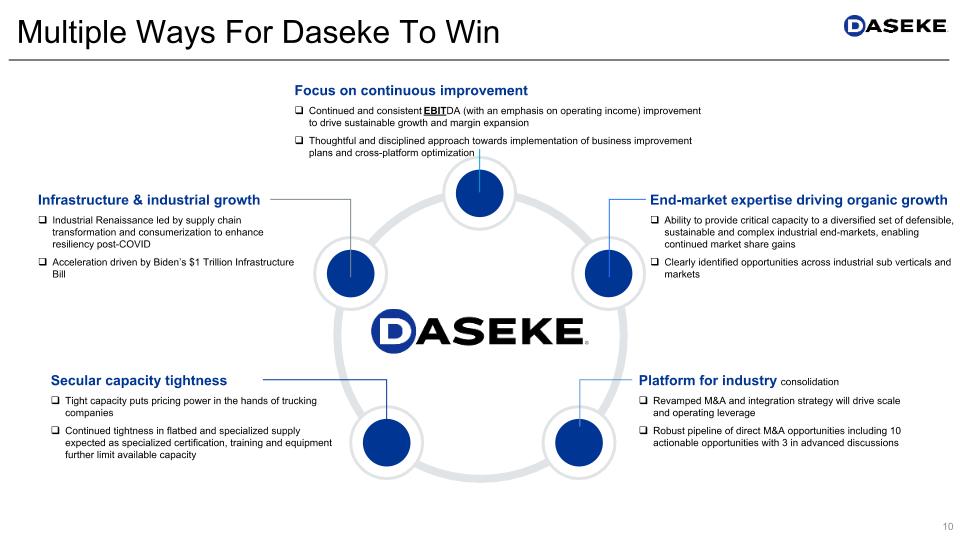
Multiple Ways For Daseke To Win Focus on continuous improvement Continued and consistent EBITDA (with an emphasis on operating income) improvement to drive sustainable growth and margin expansion Thoughtful and disciplined approach towards implementation of business improvement plans and cross-platform optimization End-market expertise driving organic growth Ability to provide critical capacity to a diversified set of defensible, sustainable and complex industrial end-markets, enabling continued market share gains Clearly identified opportunities across industrial sub verticals and markets Platform for industry consolidation Revamped M&A and integration strategy will drive scale and operating leverage Robust pipeline of direct M&A opportunities including 10 actionable opportunities with 3 in advanced discussions Infrastructure & industrial growth Industrial Renaissance led by supply chain transformation and consumerization to enhance resiliency post-COVID Acceleration driven by Biden’s $1 Trillion Infrastructure Bill Secular capacity tightness Tight capacity puts pricing power in the hands of trucking companies Continued tightness in flatbed and specialized supply expected as specialized certification, training and equipment further limit available capacity
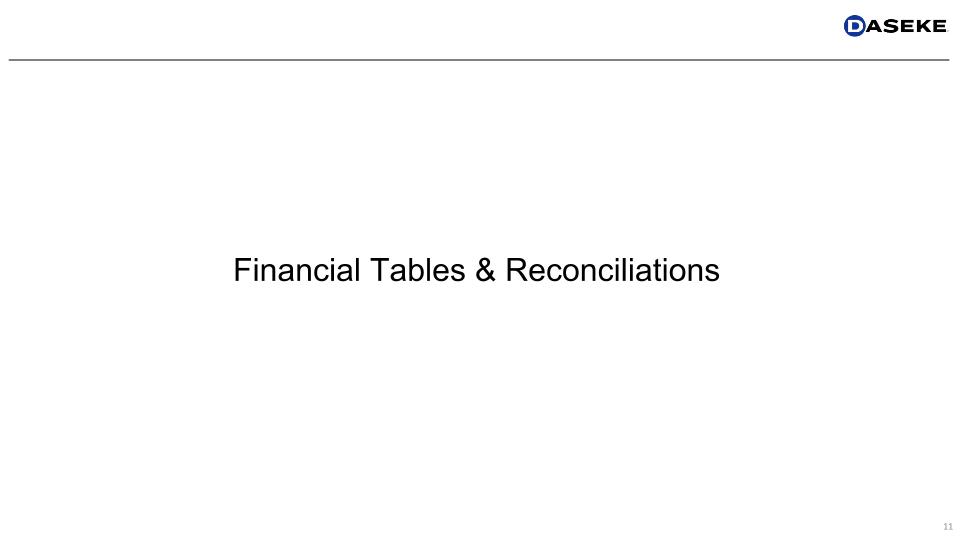
Financial Tables & Reconciliations
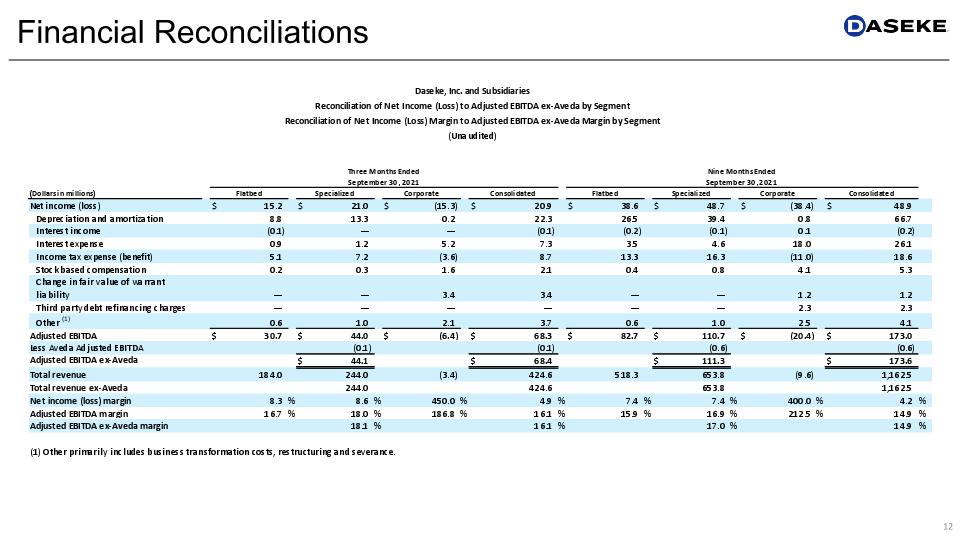
Financial Reconciliations
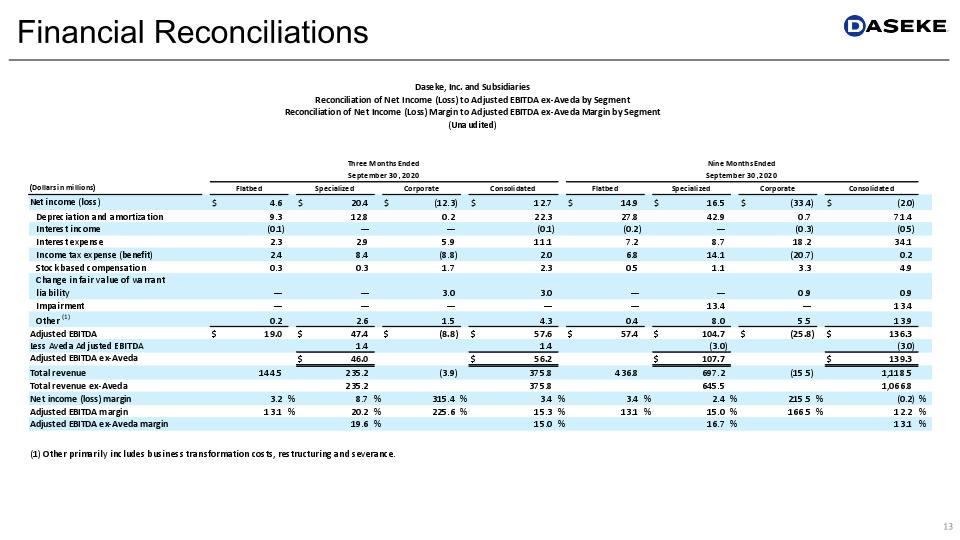
Financial Reconciliations
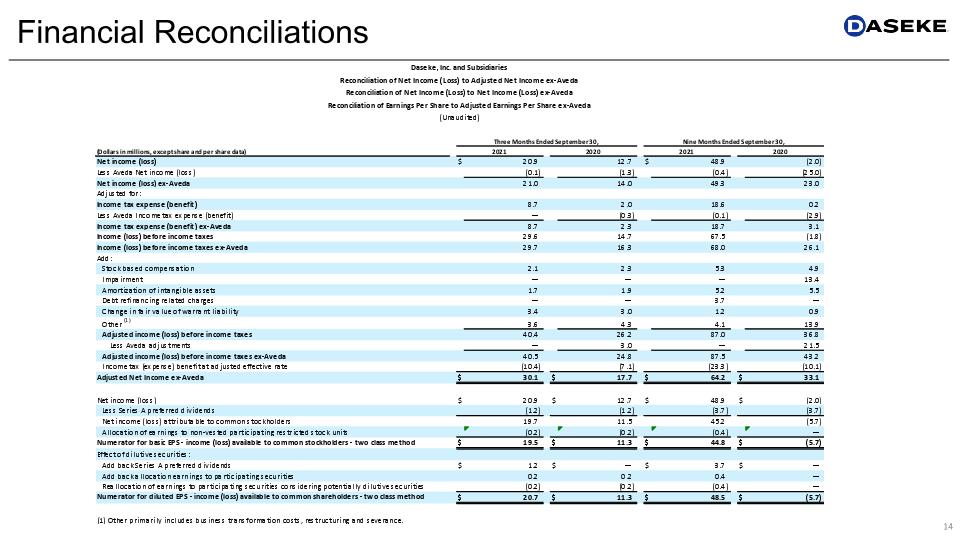
Financial Reconciliations
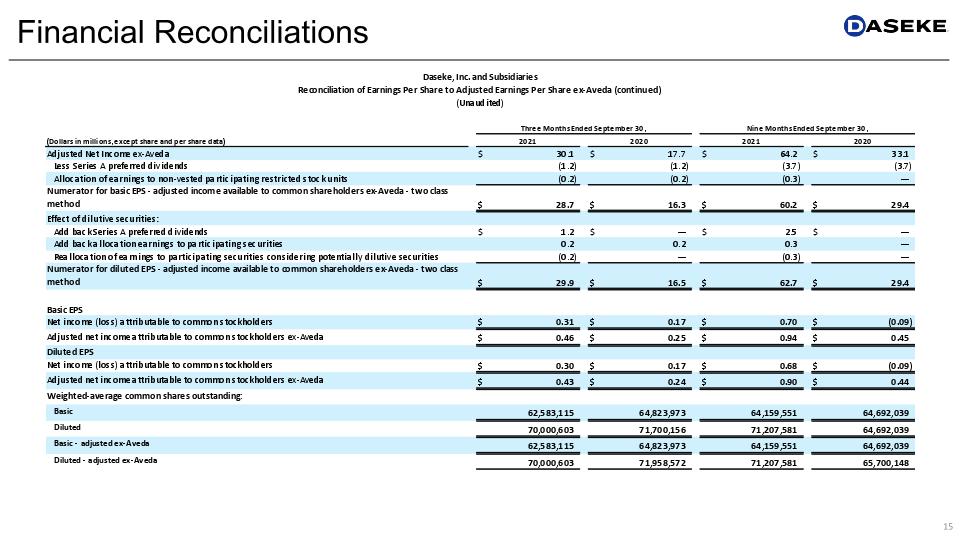
Financial Reconciliations
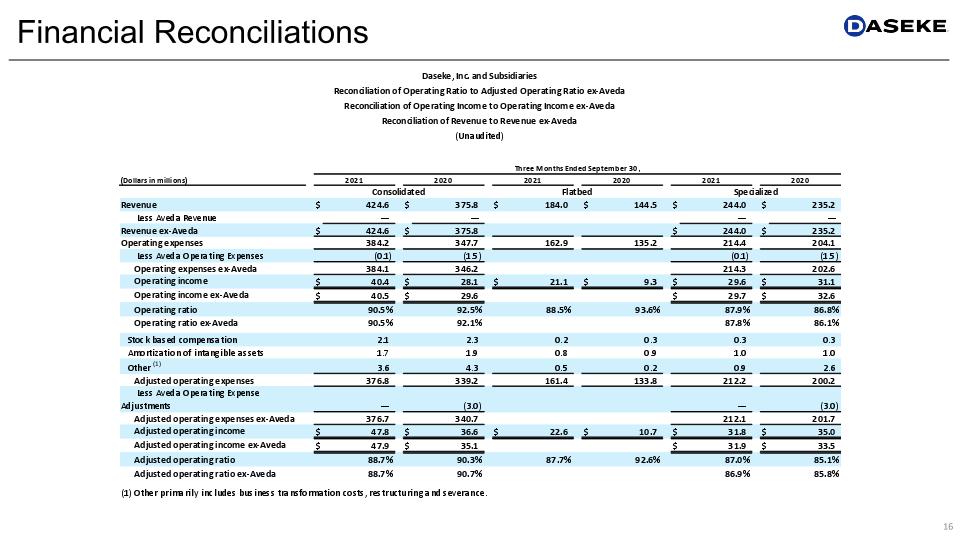
Financial Reconciliations
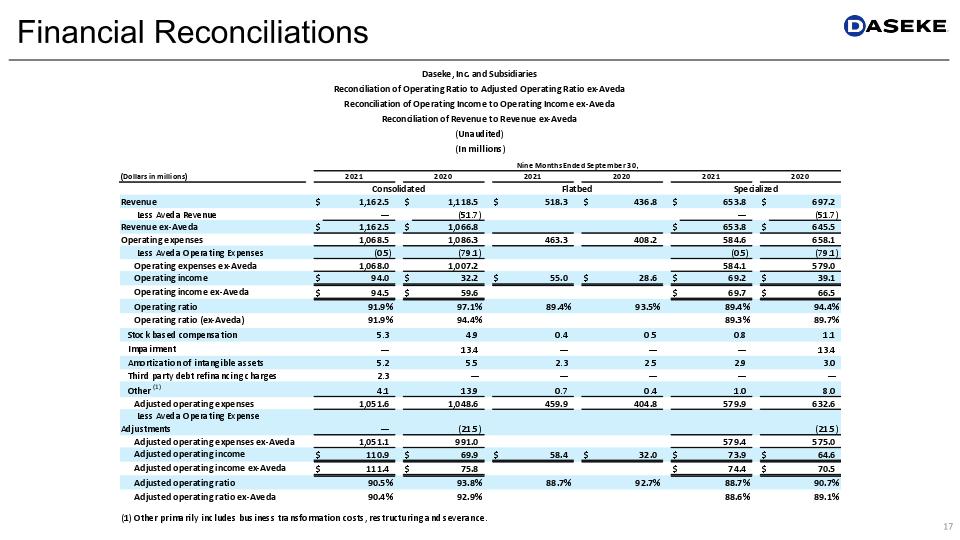
Financial Reconciliations
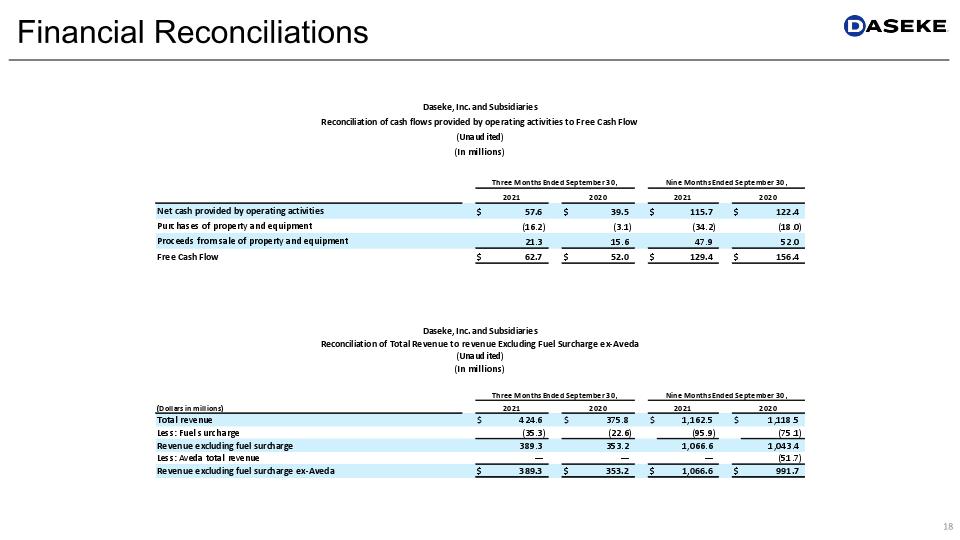
Financial Reconciliations
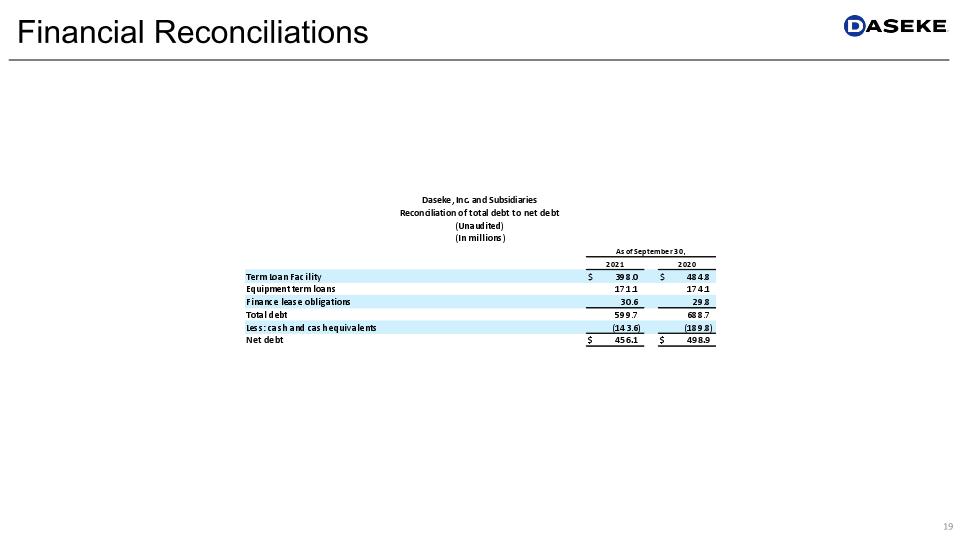
Financial Reconciliations
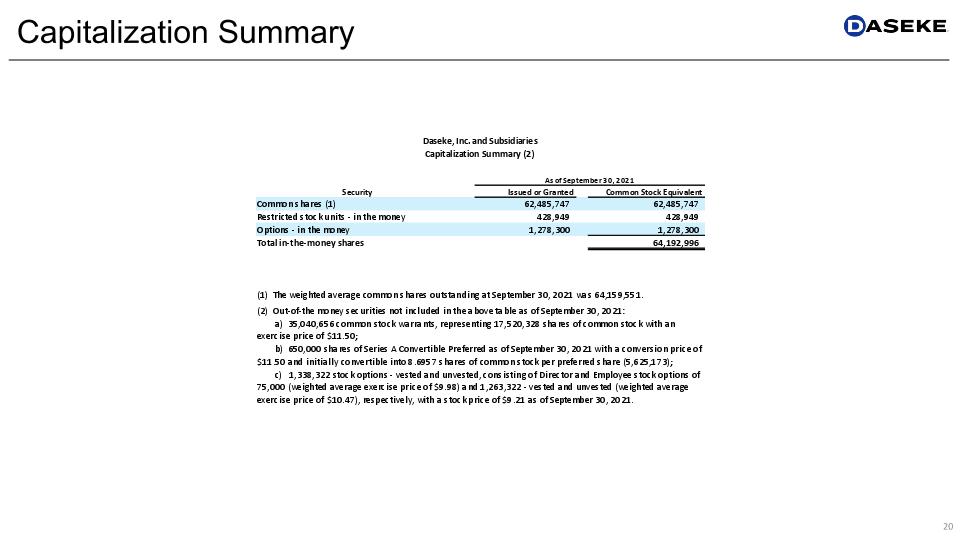
Capitalization Summary
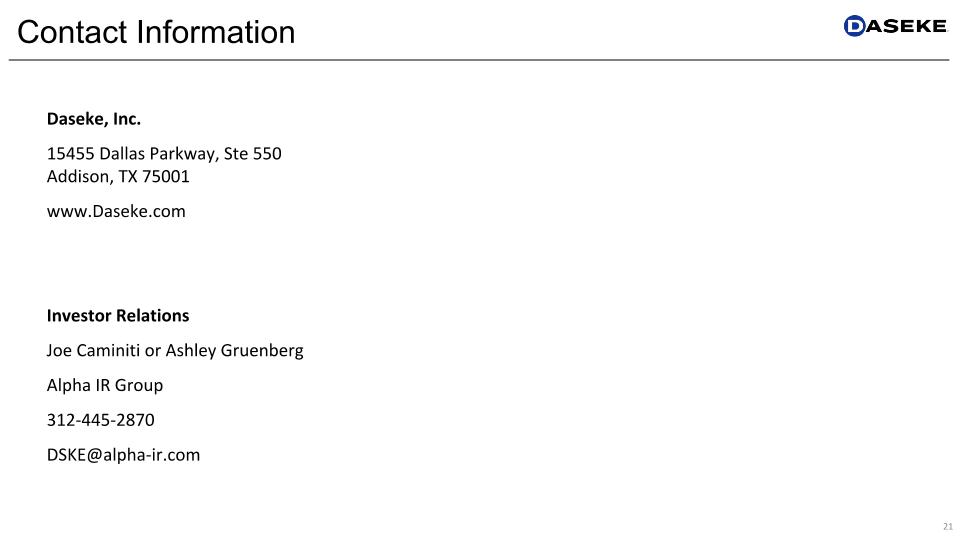
Daseke, Inc. 15455 Dallas Parkway, Ste 550�Addison, TX 75001 www.Daseke.com Investor Relations Joe Caminiti or Ashley Gruenberg Alpha IR Group 312-445-2870 DSKE@alpha-ir.com Contact Information




















